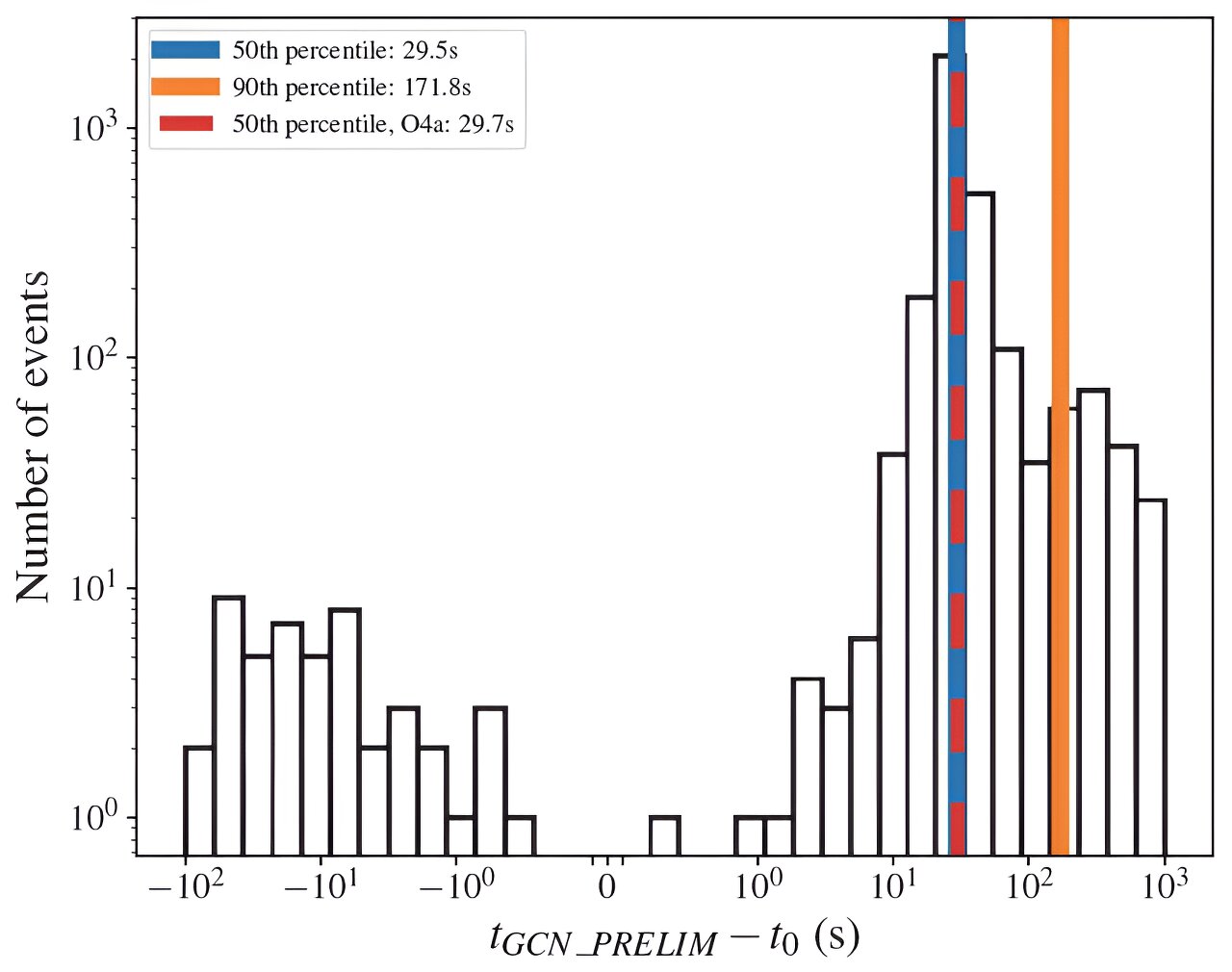This chart shows how long it takes researchers to send an alert, the average alert time is less than 30 seconds. Credit: Andrew Toivonen
x to close
This chart shows how long it takes researchers to send an alert, the average alert time is less than 30 seconds. Credit: Andrew Toivonen
Researchers at the University of Minnesota Twin Cities’ College of Science and Engineering, in collaboration with an international team, have conducted a new study that improves the detection of gravitational waves – ripples in space and time.
The purpose of this research is to send an alert to astronomers and astrophysicists within 30 seconds of discovery, to help improve the understanding of neutron stars and black holes and how heavy elements such as gold and uranium are produced.
This article titled “Low Delay Gravitational Wave Warning Products and Their Performance During the Fourth LIGO-Virgo-KAGRA Observational Run” was recently published in Proceedings of the National Academy of Sciences.
Gravitational waves interact with spacetime by compressing spacetime in one direction and stretching it in a perpendicular direction. That’s why current state-of-the-art gravitational wave detectors are L-shaped and measure the relative length of the laser using interferometry, a measurement method that looks at the interference patterns produced by combining two light sources.
Detecting gravitational waves requires measuring the length of the laser to precise measurements: the equivalent of measuring the distance to the nearest star, about four light-years from us, to the width of a human hair.
The research is part of the LIGO-Virgo-KAGRA (LVK) collaboration, a worldwide network of gravitational wave interferometers.
In the latest simulation campaign, data from previous observation periods were used and simulated gravitational wave signals were added to demonstrate software performance and equipment upgrades. The software can identify the shape of the signals, track how the signal behaves, and estimate what mass is included in the event, such as neutron stars or black holes. Neutron stars are the smallest and most dense stars that exist and form when massive stars explode in supernovae.
When the software detects a gravitational wave signal, it sends alerts to subscribers, usually astronomers or astrophysicists, about where it is in the sky. By improving this observation period, scientists can send alerts faster, less than 30 seconds, after detecting a gravitational wave.
“With this software, we can detect gravitational waves from colliding neutron stars that are normally too faint to see unless we know exactly where to look,” said Andrew Toivonen, Ph.D., Ph.D. Student at the School of Physics and Astronomy at the University of Minnesota Twin Cities.
“The detection of gravitational waves will first help locate the collision and help astronomers and astrophysicists complete further investigations.”
Astronomers and astrophysicists can use this information to understand how neutron stars behave, study nuclear reactions between neutron stars and black holes, and how heavy elements such as gold and uranium are produced.
This is the fourth observation using the Laser Interferometer Gravitational-Wave Observatory (LIGO) and will be observed until February 2025. Between the last three observation periods, scientists have made progress in detecting the signals. After the end of this observation period, the researchers will continue to review the data and make further improvements with the goal of sending out warnings more quickly.
The multi-institutional paper included Michael Coughlin, an assistant professor in the School of Physics and Astronomy at the University of Minnesota, in addition to Toivonen.
more information:
Sushant Sharma Chaudhary et al., Low-delay gravitational wave warning products and their performance during the fourth run of the LIGO-Virgo-KAGRA observatory, Proceedings of the National Academy of Sciences (2024). DOI: 10.1073/pnas.2316474121
Magazine information:
Proceedings of the National Academy of Sciences
#Researchers #advancing #detection #gravitational #waves #investigate #collisions #neutron #stars #black #holes
